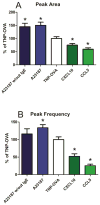Single-cell analysis of mast cell degranulation induced by airway smooth muscle-secreted chemokines
- PMID: 25986989
- PMCID: PMC4516622
- DOI: 10.1016/j.bbagen.2015.05.008
Single-cell analysis of mast cell degranulation induced by airway smooth muscle-secreted chemokines
Abstract
Background: Asthma is a chronic inflammatory disease characterized by narrowed airways, bronchial hyper-responsiveness, mucus hyper-secretion, and airway remodeling. Mast cell (MC) infiltration into airway smooth muscle (ASM) is a defining feature of asthma, and ASM regulates the inflammatory response by secreting chemokines, including CXCL10 and CCL5. Single cell analysis offers a unique approach to study specific cellular signaling interactions within large and complex signaling networks such as the inflammatory microenvironment in asthma.
Methods: Carbon-fiber microelectrode amperometry was used to study the effects of ASM-secreted chemokines on mouse peritoneal MC degranulation.
Results: MC degranulation in response to CXCL10 and CCL5 was monitored at the single cell level. Relative to IgE-mediated degranulation, CXCL10- and CCL5-stimulated MCs released a decreased amount of serotonin per granule with fewer release events per cell. Decreased serotonin release per granule was correlated with increased spike half-width and rise-time values.
Conclusions: MCs are directly activated by ASM-associated chemokines. CXCL10 and CCL5 induce less robust MC degranulation compared to IgE- and A23187-stimulation. The kinetics of MC degranulation are signaling pathway-dependent, suggesting a biophysical mechanism of regulated degranulation that incorporates control over granule trafficking, transport, and docking machinery.
General significance: The biophysical mechanisms, including variations in number of exocytotic release events, serotonin released per granule, and the membrane kinetics of exocytosis that underlie MC degranulation in response to CXCL10 and CCL5 were characterized at the single cell level. These findings clarify the function of ASM-derived chemokines as instigators of MC degranulation relative to classical mechanisms of MC stimulation.
Keywords: Asthma; Carbon-fiber microelectrode amperometry; Exocytosis.
Copyright © 2015 Elsevier B.V. All rights reserved.
Figures




Similar articles
-
Th2 cytokine-primed airway smooth muscle cells induce mast cell chemotaxis via secretion of ATP.J Asthma. 2014 Dec;51(10):997-1003. doi: 10.3109/02770903.2014.939283. Epub 2014 Oct 9. J Asthma. 2014. PMID: 25272186
-
Epithelium-derived chemokines induce airway smooth muscle cell migration.Clin Exp Allergy. 2009 Jul;39(7):1018-26. doi: 10.1111/j.1365-2222.2009.03238.x. Epub 2009 Apr 2. Clin Exp Allergy. 2009. PMID: 19364333
-
Plasmodium chabaudi Affects Mast Cell Degranulation as Measured by Carbon-Fiber Microelectrode Amperometry.ACS Infect Dis. 2021 Jun 11;7(6):1650-1656. doi: 10.1021/acsinfecdis.0c00820. Epub 2021 Apr 15. ACS Infect Dis. 2021. PMID: 33856187
-
The role of the mast cell in asthma: induction of airway hyperresponsiveness by interaction with smooth muscle?J Allergy Clin Immunol. 2004 Jul;114(1):58-65. doi: 10.1016/j.jaci.2004.03.034. J Allergy Clin Immunol. 2004. PMID: 15241345 Review.
-
The role of the mast cell in asthma: a reassessment.Curr Opin Allergy Clin Immunol. 2003 Feb;3(1):45-50. doi: 10.1097/00130832-200302000-00008. Curr Opin Allergy Clin Immunol. 2003. PMID: 12582314 Review.
Cited by
-
Enteric Neuronal Regulation of Intestinal Inflammation.Trends Neurosci. 2016 Sep;39(9):614-624. doi: 10.1016/j.tins.2016.06.007. Epub 2016 Jul 20. Trends Neurosci. 2016. PMID: 27450201 Free PMC article. Review.
-
Platelet Response to Allergens, CXCL10, and CXCL5 in the Context of Asthma.ACS Bio Med Chem Au. 2022 Dec 2;3(1):87-96. doi: 10.1021/acsbiomedchemau.2c00059. eCollection 2023 Feb 15. ACS Bio Med Chem Au. 2022. PMID: 36820311 Free PMC article.
-
Serotonergic Mechanisms Regulating the GI Tract: Experimental Evidence and Therapeutic Relevance.Handb Exp Pharmacol. 2017;239:319-342. doi: 10.1007/164_2016_103. Handb Exp Pharmacol. 2017. PMID: 28035530 Free PMC article. Review.
-
The impact of vitamin D on asthmatic human airway smooth muscle.Expert Rev Respir Med. 2016 Feb;10(2):127-35. doi: 10.1586/17476348.2016.1128326. Epub 2015 Dec 28. Expert Rev Respir Med. 2016. PMID: 26634624 Free PMC article.
-
Mast Cell-Mediated Orchestration of the Immune Responses in Human Allergic Asthma: Current Insights.Clin Rev Allergy Immunol. 2019 Apr;56(2):234-247. doi: 10.1007/s12016-018-8720-1. Clin Rev Allergy Immunol. 2019. PMID: 30506113 Review.
References
-
- E.P.O.T.M.O. Asthma, Expert Panel Report 3: Guidelines for the diagnosis and management of asthma. US Patent Office; 2007.
-
- Bradding P, Walls AF, Holgate ST. The role of the mast cell in the pathophysiology of asthma. Journal of Allergy and Clinical Immunology. 2006;117:1277–1284. - PubMed
-
- Poon AH, Eidelman DH, Martin JG, Laprise C, Hamid Q. Pathogenesis of severe asthma. Clinical & Experimental Allergy. 2012;42:625–637. - PubMed
-
- Holgate ST, Davies DE. Rethinking the Pathogenesis of Asthma. Immunity. 2009;31:362–367. - PubMed
Publication types
MeSH terms
Substances
Grants and funding
LinkOut - more resources
Full Text Sources
Other Literature Sources
Molecular Biology Databases

